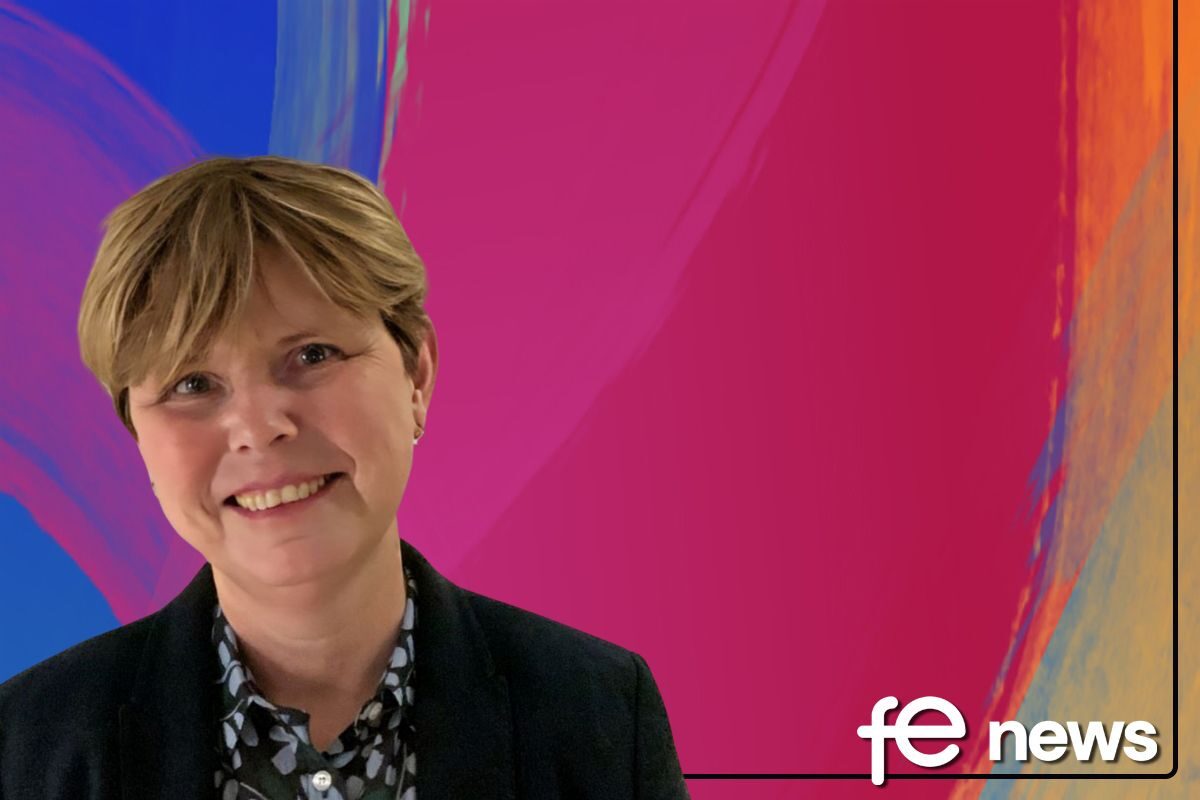Towards LGBTQ+ inclusion in FE

In this article, Dr Catherine Lee (MBE) discusses the impact of state-sanctioned homophobia created by Section 28, and practical ways FE schools and colleges can move forward from that legacy towards inclusion.
In June, my niece and nephew entered the gates of their secondary school in rural East Anglia, under a huge rainbow archway of balloons. This was just part of their school’s Pride celebrations, and along with their peers they spent Pride Month hearing from inspirational LGBTQ+ speakers, studying LGBTQ+ figures in history and even attending a Pride disco. I doubt many current secondary or FE teachers are surprised to read this and I imagine that similar Pride celebrations took place across the UK.
Schools and FE colleges were not always like this though. For years, they were challenging environments for LGBTQ+ teachers and lesbian and gay students; and the fifteen years of state-sanctioned homophobia via Section 28 of the Local Government Act, left a damaging legacy which is still evident today.
Section 28
Section 28 of the Local Government Act (1988-2003) stated:
‘A local authority shall not intentionally promote homosexuality or promote the teaching in any maintained school of the acceptability of homosexuality as a pretended family relationship.’
What did this mean for teachers and students?
Teachers were confused about what they could and could not say and do. LGBTQ+ young people could not receive any support from school staff, and local authorities withdrew all services for LGBTQ+ groups and communities. LGBTQ+ teachers believed they could not talk about their personal lives and would lose their jobs if they came out (or were outed) in the school workplace.
Towards LGBTQ+ inclusion in FE
Thankfully, since Section 28, there have been a number of important milestones in the UK and around the world, that have positively impacted the lived experience of LGBTQ+ people. The first is the Equality Act 2010. The Act brought together a number of protections in education, the workplace and wider society to provide a single, consolidated source of UK discrimination law.
The government distilled aspects of the Equality Act that were relevant to education, into a single guidance paper (Department for Education, 2014). The paper stresses that stakeholders must not be discriminated against on the grounds of their sex, race, disability, religion or belief, or sexual orientation. It also emphasises that, for the first time, protections are extended to students who are pregnant or have recently given birth, or who are undergoing gender reassignment.
Protection from discrimination on the grounds of gender reassignment is defined in the Equality Act as applying to anyone who is undergoing, has undergone or is proposing to undergo a process (or part of a process) of reassigning their sex by changing physiological or other attributes.
This definition means that to be protected under the act, a student does not necessarily have to be undertaking a medical procedure to change their gender, but should be taking steps to live in the opposite gender. Gender reassignment guidance from the government for teachers and other adults in schools and colleges is covered via the Gender Recognition Act 2004.
Schools and colleges are instructed under the Equality Act to make sure that all ‘gender variant’ students, or the children of transgender parents, are not singled out for different and less favourable treatment (Department for Education, 2014).
On sexual orientation and in particular the teaching of marriage and civil partnerships, the guidance notes that schools and colleges must make sure students who identify as LGBTQ+ or are the children of LGBTQ+ parents, are not singled out for different and less favourable treatment.
If we think we have achieved LGBTQ+ inclusion in UK schools and colleges, we are mistaken
Over the past two decades, the Equality Act has done a good deal to improve the climate for LGBTQ+ teachers, adults and young people in education. But we rest on our laurels at our peril. If we think we have achieved LGBTQ+ inclusion in UK schools and colleges, we are mistaken. For many of our trans and non-binary students and teachers, this era is their Section 28. We have in the current Conservative government, leaders with a concerning track record on LGBTQ+ inclusion, and in particular, trans inclusion.
Learning lessons from some worrying developments in the USA
On the broader issue of LGBTQ+ inclusion, we must keep moving forward and learn lessons from some worrying developments in the USA, in states such as Florida. The Parental Rights in Education Act 2022, nicknamed the ‘don’t say gay’ law by critics, is Section 28 by another name. There are reports that some schools and colleges across Florida have removed LGBTQ+ inclusive books from their libraries and withdrawn textbooks containing references to LGBTQ+ people (Brangham & Hastings, 2022).
Florida teachers with same-sex partners, have been compelled to remove photographs of their loved ones from their desks, fearing that being out at school could make their roles untenable under the new law. This is all remarkably familiar.
We have, though, come a long way since the repeal of Section 28 and there is much to celebrate in UK schools and colleges at present, but there is still work to be done to achieve inclusivity.
The current picture for LGBTQ+ students in the UK
Stonewall’s latest School Report (Bradlow et al, 2017), surveyed over 3,700 lesbian, gay, bi and trans (LGBT) young people across Britain aged 11–19. The key findings from Stonewall are alarming:
- 45% of LGBTQ+ students are bullied for being LGBTQ+ at school or in college
- 64% of trans students are bullied
- 86% regularly hear phrases such as ‘that’s so gay’ or ‘you’re so gay’ in school
- 84% have self-harmed.
The current picture for LGBTQ+ staff in the UK
Research by Lee (2019) found that:
- 13% of LGBTQ+ teachers had left a job because of homophobia
- only 22% of LGBTQ+ teachers were out to staff and students in schools and colleges
- 40% of teachers heard homophobic language at least once a week
- 62% of teachers had accessed help for anxiety or depression linked to their sexual/ gender identity and role as a teacher.
Five things FE leaders can do
FE college leaders have an important role to play around every aspect of LGBTQ+ inclusion. Ensuring decision making processes are transparent and accountable, and delegating responsibilities to encourage a transformed FE community, are essential to the success of LGBTQ+ inclusion.
1. Be familiar with the law
Education leaders should provide an environment where LGBTQ+ staff, volunteers, parents, carers, and young people, are safe and free to be themselves and experience acceptance from adults and other young people. LGBTQ+ inclusion is essential to a broad and balanced education, and supports members to deliver good, evidence-based practice, rather than simply meeting legal requirements. However, if you are facing challenges in your education setting, knowing the law can help. There are several pieces of legislation and statutory guidance relevant to LGBTQ+ inclusion:
Advancing equality (Public Sector Equality Duty, Equality Act 2010)
Schools and colleges have a duty under the Equality Act 2010, to ensure that teaching is accessible and inclusive to all children and young people, including those who are LGBTQ+, and to teach in a non-discriminatory way.
Preventative anti-bullying measures (Section 89, Education Inspections Act 2006)
Schools and colleges have a duty not just to safeguard after an incident of bullying, but also to have preventative anti-bullying measures. LGBTQ+ inclusive education is a core aspect of preventative anti-bullying measures, as it fosters good relationships and looks at the impact of homo/trans/bi-phobic bullying.
Broad and balanced curriculum (Section 78, Education Act 2002).
The Education Act requires schools to promote the spiritual, moral, cultural, mental and physical development of students and prepare them for their adult lives. All young people will have LGBTQ+ friends, family and/or peers, so teaching about the existence of LGBTQ+ people and their rights by law is essential to a broad and balanced education.
Safeguarding children (Keeping children safe in Education 2019; Section 175 of the Education Act 2002)
There is a duty on all maintained schools and colleges to safeguard and promote the welfare of students. LGBTQ+ students are entitled to an education free from bullying, abuse and harassment.
2. Create a safe and inclusive environment for LGBTQ+ staff and students
Foster a safe environment in the FE workplace in which heterosexual staff members are encouraged to be allies to LGBTQ+ teachers. Provide opportunities for LGBTQ+ teacher identities to be acknowledged, and spoken into existence in the staffroom and the classroom.
Have a culture of zero tolerance for homophobic and transphobic language, and deal with it exactly as you would a racist incident. Celebrate LGBTQ+ teachers as role models.
Situating LGBTQ+ inclusion in the context of wider equality, gives a powerful message about the benefits everyone experiences when education is truly inclusive. Ensuring representation and celebration of people across faiths, ethnicities, sexual orientations, gender identities and expressions, class backgrounds, family types, nationalities and ages, ensures every young person is included and informed about the true diversity around them.
LGBTQ+ inclusion cannot be considered an add-on or an optional aspect of this comprehensive inclusion. FE values should support an LGBTQ+ inclusive school community and embed an LGBTQ+ inclusive culture.
3. Listen to LGBTQ+ members of your community
LGBTQ+ inclusion, requires listening to LGBTQ+ people in your community, including students, staff, governors and the wider community. LGBTQ+ people will be a minority in any setting, so engaging with the LGBTQ+ community both within and outside the school or college, and ensuring their voices are heard, is critical to effective LGBTQ+ inclusion.
No one is immune from the negative and harmful messaging about LGBTQ+ people that permeates our society. LGBTQ+ inclusion requires un-learning what we have absorbed from a homo/bi/transphobic society. It involves learning more about the diversity of the LGBTQ+ community, and the unique needs and experiences of LGBTQ+ people.
Specialist training and development activities can support your staff team to become more LGBTQ+ inclusive. Local community organisations and leaders can be utilised in LGBTQ+ inclusion work, to bring new perspectives, resources and approaches into the FE community.
4. Celebrate LGBTQ+ lives in the curriculum throughout the year, not just during LGBTQ+ History Month
Teach about LGBTQ+ rights movements and LGBTQ+ peoples’ involvement in culture, music, science, philosophy, politics and art, in the UK and globally.
Teach about the prevalence and resistance to homophobia, biphobia, transphobia and the oppression of gender and sexually diverse people, including the impact of colonisation, on LGBTQ+ people’s rights and experiences globally.
Review lesson plans across all subjects to eliminate heteronormative bias, to challenge gender stereotypes; to ensure diverse families, sexual orientations and gender identities are represented across all subjects.
5. Commit to specialist staff training on LGBTQ+ inclusion
Stonewall is an LGBTQ+ charity and lobbying group. They have spent more than 30 years training schools and colleges on LGBTQ+ inclusion in education. They offer CPD accredited online training, as well as membership programmes for schools and colleges in the UK. Alongside this, staff can benefit from their extensive resources and consultancy services.
Diversity Role Models education services are developed in collaboration with leading educators and inclusion experts, and aim to embed inclusion and empathy. Their delivery model is adaptable to the specific challenges and needs of schools and colleges. Workshops are interactive, educational and delivered by highly qualified facilitators. The signature highlight of each Diversity Role Models Workshop is hearing from LGBTQ+ or ally role models about their lived experience.
Diverse Educators is a team of experienced associates who run DEI training. They design and deliver different DEI sessions including: masterclasses, induction sessions, INSET and twilight sessions, conference workshops and keynotes. They also have online resources and toolkits which are really helpful.
There are also a number of smaller charity organisations that do direct work with LGBTQ+ young people and families, that also deliver high quality training. The LGBT Consortium should be able to signpost local training providers.
By Professor Catherine Lee (MBE)
About Professor Catherine Lee (MBE)
Professor Catherine Lee has an MBE for services to equality in education. She is also a National Teaching Fellow in recognition of her work to improve the national landscape in schools and universities.
Before working in higher education, Catherine spent over twenty years as a teacher, both in inner-city Liverpool and rural Suffolk. She was initially a PE teacher before gaining promotion to learning development and pastoral leadership roles in mainstream schools.
Catherine has published extensively on the theme of LGBTQ+ inclusion in schools. In 2016, working with schools she helped to set up Courageous Leaders, a leadership development programme for LGBTQ+ teachers
Catherine has been nominated for a number of national awards for her work in education, including a British Diversity Award and National Diversity Award. She also featured in the LGBT Pride Power List in 2019 as one of the most influential LGBT people in the UK. Catherine has a number of strategic governance roles in the education and charity sectors, where she uses her national profile in pursuit of inclusive education and to improve the lives of those on the margins.
Dr Catherine Lee (MBE), author of Pretended: Schools and Section 28: Historical, Cultural and Personal Perspectives published by John Catt Educational, discusses moving forward from the legacy of Section 28.











Responses